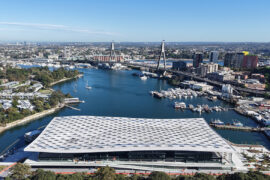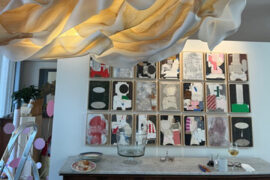Indesignlive Asia take a look at two evocative dining spaces by design team Asylum
November 1st, 2012
It is often said that the appreciation of Japanese cuisine starts with the eyes. In Japanese dining, the artful arrangement of the dish, the beautiful tableware and the ambience are just as important as the food itself.
Asylum appears to rise to the challenge with not one but two visually (and creatively) arresting dining concepts for client Iki Concepts. Kaiseki Yoshiyuki offers traditional Kaiseki cuisine in an elegantly modern setting while Horse’s Mouth is a playful speakeasy-style Izakaya serving Japanese bar food and cocktails.

Both are housed within the same 418sqm space in the basement of Forum the Shopping Mall, Singapore. But that’s where the similarities end.
To get to Kaiseki Yoshiyuki, one has to make one’s way past a dark and enigmatic 5-metre walkway, whereupon an intimate 14-seater counter dining area comes into view. Here, walls clad in roof tiles – a nod to the temple roofs of Kyoto – pay homage to the Zen Buddhist origins of Kaiseki.


Ash paneled geometrical forms cast intriguing wall details in the warmly lit interior while touches of colour peek in from cutout windows of the origami flower display. All these carefully orchestrated elements then serve as a visual prelude to the intricately prepared degustation course that awaits.


To get to Horse’s Mouth, one has to enter via a separate ’secret entrance’ located at Uma Uma Ramen restaurant (another establishment under Iki Concepts) located one floor above – enhancing the exclusivity and underground personality of the Izakaya. Down a flight of stairs and into Horse’s Mouth proper, 3,000 origami flowers housed in glass displays create an explosion of colour amidst dark leather seats and wooden tables, while a wall lined with images of books on shelves create an illusion of a well-stocked library.

Asylum
INDESIGN is on instagram
Follow @indesignlive
A searchable and comprehensive guide for specifying leading products and their suppliers
Keep up to date with the latest and greatest from our industry BFF's!

Rising above the new Sydney Metro Gadigal Station on Pitt Street, Investa’s Parkline Place is redefining the office property aesthetic.
It was a boisterous and happy crowd that attended the latest Objective Light event at InterfaceFLOR’s Sydney showroom on 9 September 2009.

Step inside Perth’s newest multi-residential development: M/24 by Match.

We sit down with Astro Lighting’s Cofounder and Design Director, James Bassant, to talk about the design philosophy fuelling the international success of the brand, the importance of being accessible – and why Astro never aspired to be achingly cool.
The internet never sleeps! Here's the stuff you might have missed

With a date now set for January 2026, Sydney’s landmark project is taking shape as a significant and welcome addition to civic life in the city.

Held in a private Melbourne residence, Fletcher Arts’ annual exhibition unites over 30 Australian artists and designers in a setting where art meets architecture.